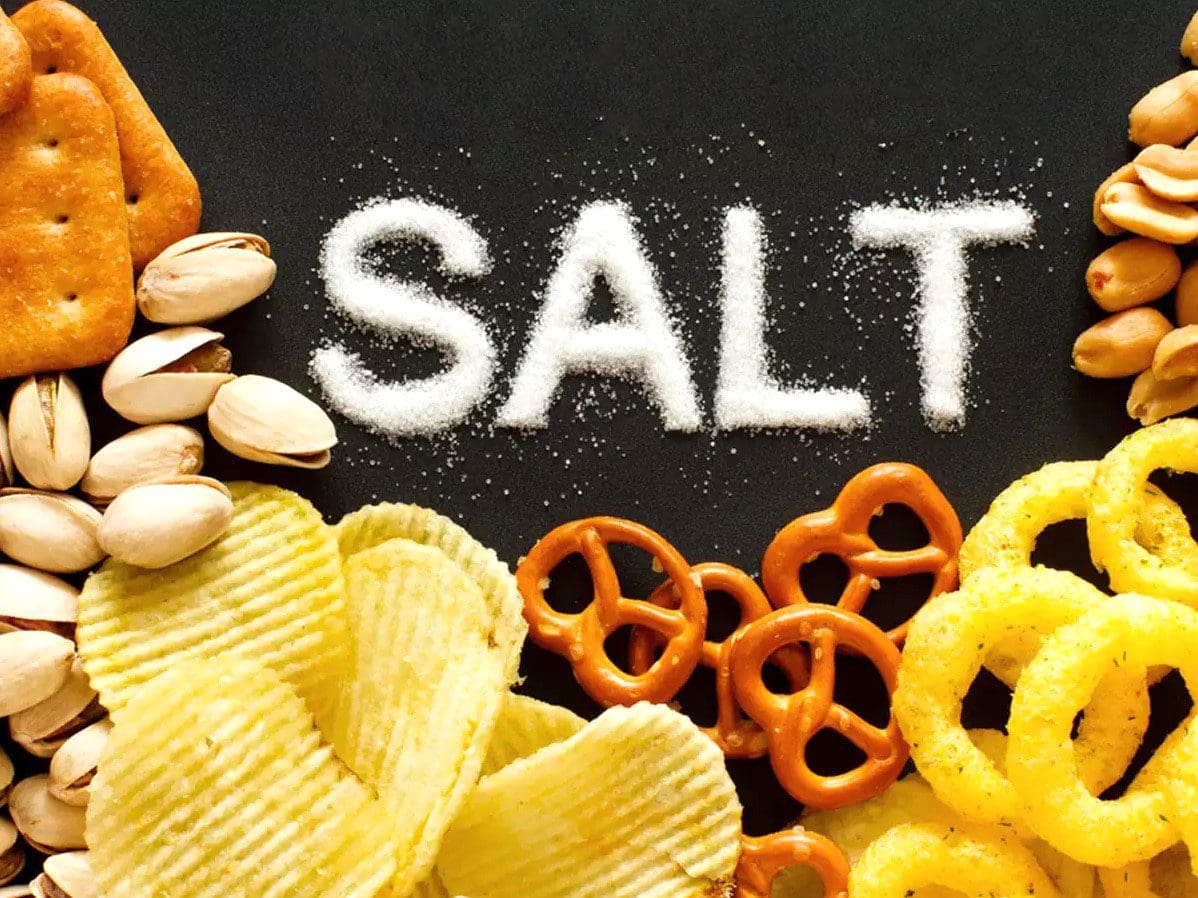Although salt is satisfying to the palate and necessary for survival, when the body craves salt, it can be a symptom of a health condition/s. The body needs sodium, but many foods contain more than the body needs. Most individuals’ sodium intake comes from packaged foods, pizza, burgers, and soups. The body craves salty foods for various reasons, often related to a sodium imbalance. To help curb cravings and limit consumption, incorporate seasoning blends, spices, and vegetables into a nutritional plan. Injury Medical Chiropractic and Functional Medicine Clinic can provide expert diet recommendations and health coaching to develop a personalized nutrition plan.

Table of Contents
When The Body Craves Salt
According to the American Heart Association:
- The body needs 500 milligrams (mg) of sodium daily for optimal functioning.
- That’s less than one-fourth of a teaspoon (tsp).
- But because most individuals take in around 3,400 mg every day, the American Heart Association recommends that adults reduce consumption to 1,500-2,300 mg of salt daily.
- Individuals who crave salt often shouldn’t ignore this as cravings could signal a health condition.
- It is recommended to seek a healthcare provider’s advice to evaluate nutrition and lifestyle.
Causes
Dehydration
Craving salt could mean the body needs hydration. A sodium deficiency triggers systems that generate cravings for sodium, and the body feels rewarded after consuming salty foods. Individuals that find themselves dehydrated often should consider following these tips to maintain healthy body hydration:
- Carry a water bottle throughout the day, take frequent sips, and try to refill two or more times.
- Add fruit or fresh herbs to the water for flavor.
- Freeze water bottles to have ice-cold water readily available.
- Ask for water alongside other beverages when dining out.
Electrolyte Imbalance
- When electrolytes are out of balance, the body can crave salty foods.
- Electrolytes are minerals in the body with an electric charge.
- Electrolytes are in the blood, urine, and tissues, and levels can spike or plummet.
- This occurs when the amount of water taken does not equal the amount lost because of excessive sweating, sickness, and/or frequent urination.
- Electrolytes are important because:
- They help balance the body’s water equilibrium and pH levels
- Move nutrients and waste into and out of the cells
- Ensure the nerves, muscles, and brain are at optimal function.
Stress
- Eating behavior can quickly be disrupted when experiencing stressful situations.
- A stressed body can feel better after eating the foods it is used to, especially for individuals that consume a lot of salty foods when things are normal, and there is no stress.
Boredom
- Eating because of boredom is an emotional eating behavior similar to stress eating.
- This response to negative emotions can happen to anyone.
- Individuals are recommended to work through their negative thoughts with stress reduction strategies that include:
- Mindful eating.
- Exercise.
- Meditation.
- Spending time in green spaces like a garden, park, etc.
- Visits with friends and family.
Pre-Menstruation
- Women can experience increased food cravings during pre-menstrual hormonal changes.
Pregnancy
- Experiencing various types of cravings during pregnancy is different for all women that naturally occurs.
- However, cravings for salty foods often occur in the later stages of pregnancy.
Addison’s Disease
- Addison’s disease is when the adrenal glands do not produce enough of a certain hormone, like cortisol/the stress hormone.
- Individuals with this condition could be recommended to consume a high-sodium diet.
- A nutritional healthcare professional can recommend what sodium sources and how much sodium are best.
Prevent Salt Cravings
Individuals can replace sodium with salt-free substitutes that do not help maintain flavor. Options include the following:
Citrus
- Using fresh citrus juice can brighten up dishes with acid.
- When a dish tastes flat, a little acid from lemon juice can help make the food more palatable.
Vinegar
- Vinegar can brighten the flavor of foods because of its acidic content and serve as a substitute.
- Vinegar varieties include champagne, rice wine, or white balsamic.
Herbs
- Herbal salt substitutes can be used, which follow the style of Mediterranean dishes.
No-Salt Seasoning
- Salt-free seasoning blends are sold online and in grocery stores.
- Individuals can make a no-salt seasoning mix using cumin, garlic powder, onion powder, paprika, and cayenne pepper.
Garlic
- Instead of one teaspoon of iodized salt, one teaspoon of fresh garlic can eliminate up to 2,360 mg of sodium and offers an intense flavor.
Reduce Salt Consumption
The U.S. Food and Drug Administration says that reducing the amount of sodium can gradually lower cravings. Taking these steps can help:
- Limit consumption of packaged foods, especially those with the word instant in the name. These often contain a significant amount of sodium.
- If possible, prepare lunch to take to work or school.
- Read nutrition labels to ensure the products contain at least less than 2,300 milligrams of sodium.
- Stick to fresh, frozen vegetables with no seasoning added or no-salt canned vegetables.
- Split meals when eating out or cut the meal in half and take the rest home to avoid the high amounts of sodium in restaurant food.
- Use none or low-sodium salad dressings or place them on the side.
Learning About Food Substitutions
References
Bell, Victoria, et al. “One Health, Fermented Foods, and Gut Microbiota.” Foods (Basel, Switzerland) vol. 7,12 195. 3 Dec. 2018, doi:10.3390/foods7120195
Husebye, Eystein S et al. “Adrenal insufficiency.” Lancet (London, England) vol. 397,10274 (2021): 613-629. doi:10.1016/S0140-6736(21)00136-7
Morris, Michael J et al. “Salt craving: the psychobiology of pathogenic sodium intake.” Physiology & behavior vol. 94,5 (2008): 709-21. doi:10.1016/j.physbeh.2008.04.008
Orloff, Natalia C, and Julia M Hormes. “Pickles and ice cream! Food cravings in pregnancy: hypotheses, preliminary evidence, and directions for future research.” Frontiers in psychology vol. 5 1076. 23 Sep. 2014, doi:10.3389/fpsyg.2014.01076
Souza, Luciana Bronzi de et al. “Do Food Intake and Food Cravings Change during the Menstrual Cycle of Young Women?.” “A ingestão de alimentos e os desejos por comida mudam durante o ciclo menstrual das mulheres jovens?.” Revista brasileira de ginecologia e obstetricia : revista da Federacao Brasileira das Sociedades de Ginecologia e Obstetricia vol. 40,11 (2018): 686-692. doi:10.1055/s-0038-1675831
Post Disclaimer
Professional Scope of Practice *
The information herein on "When The Body Craves Salt: EP Functional Chiropractic Scientists" is not intended to replace a one-on-one relationship with a qualified health care professional or licensed physician and is not medical advice. We encourage you to make healthcare decisions based on your research and partnership with a qualified healthcare professional.
Blog Information & Scope Discussions
Welcome to El Paso's Premier Wellness, Personal Injury Care Clinic & Wellness Blog, where Dr. Alex Jimenez, DC, FNP-C, a Multi-State board-certified Family Practice Nurse Practitioner (FNP-BC) and Chiropractor (DC), presents insights on how our multidisciplinary team is dedicated to holistic healing and personalized care. Our practice aligns with evidence-based treatment protocols inspired by integrative medicine principles, similar to those found on this site and our family practice-based chiromed.com site, focusing on restoring health naturally for patients of all ages.
Our areas of multidisciplinary practice include Wellness & Nutrition, Chronic Pain, Personal Injury, Auto Accident Care, Work Injuries, Back Injury, Low Back Pain, Neck Pain, Migraine Headaches, Sports Injuries, Severe Sciatica, Scoliosis, Complex Herniated Discs, Fibromyalgia, Chronic Pain, Complex Injuries, Stress Management, Functional Medicine Treatments, and in-scope care protocols.
Our information scope is multidisciplinary, focusing on musculoskeletal and physical medicine, wellness, contributing etiological viscerosomatic disturbances within clinical presentations, associated somato-visceral reflex clinical dynamics, subluxation complexes, sensitive health issues, and functional medicine articles, topics, and discussions.
We provide and present clinical collaboration with specialists from various disciplines. Each specialist is governed by their professional scope of practice and their jurisdiction of licensure. We use functional health & wellness protocols to treat and support care for musculoskeletal injuries or disorders.
Our videos, posts, topics, and insights address clinical matters and issues that are directly or indirectly related to our clinical scope of practice.
Our office has made a reasonable effort to provide supportive citations and has identified relevant research studies that support our posts. We provide copies of supporting research studies upon request to regulatory boards and the public.
We understand that we cover matters that require an additional explanation of how they may assist in a particular care plan or treatment protocol; therefore, to discuss the subject matter above further, please feel free to ask Dr. Alex Jimenez, DC, APRN, FNP-BC, or contact us at 915-850-0900.
We are here to help you and your family.
Blessings
Dr. Alex Jimenez DC, MSACP, APRN, FNP-BC*, CCST, IFMCP, CFMP, ATN
email: coach@elpasofunctionalmedicine.com
Multidisciplinary Licensing & Board Certifications:
Licensed as a Doctor of Chiropractic (DC) in Texas & New Mexico*
Texas DC License #: TX5807, Verified: TX5807
New Mexico DC License #: NM-DC2182, Verified: NM-DC2182
Multi-State Advanced Practice Registered Nurse (APRN*) in Texas & Multi-States
Multistate Compact APRN License by Endorsement (42 States)
Texas APRN License #: 1191402, Verified: 1191402 *
Florida APRN License #: 11043890, Verified: APRN11043890 *
License Verification Link: Nursys License Verifier
* Prescriptive Authority Authorized
ANCC FNP-BC: Board Certified Nurse Practitioner*
Compact Status: Multi-State License: Authorized to Practice in 40 States*
Graduate with Honors: ICHS: MSN-FNP (Family Nurse Practitioner Program)
Degree Granted. Master's in Family Practice MSN Diploma (Cum Laude)
Dr. Alex Jimenez, DC, APRN, FNP-BC*, CFMP, IFMCP, ATN, CCST
My Digital Business Card
RN: Registered Nurse
APRNP: Advanced Practice Registered Nurse
FNP: Family Practice Specialization
DC: Doctor of Chiropractic
CFMP: Certified Functional Medicine Provider
MSN-FNP: Master of Science in Family Practice Medicine
MSACP: Master of Science in Advanced Clinical Practice
IFMCP: Institute of Functional Medicine
CCST: Certified Chiropractic Spinal Trauma
ATN: Advanced Translational Neutrogenomics





 Again, We Welcome You.
Again, We Welcome You.
Comments are closed.